Kampillaka: Mallotus philippensis Uses, Research, Remedies
Kampillaka- Mallotus philippensis is a herb mentioned in Ayurveda for the treatment of skin diseases, wound and intestinal worm.
Latin name- Mallotus philippensis Muell Arg.
Family- Euphorbiaceae (Eranda kula)
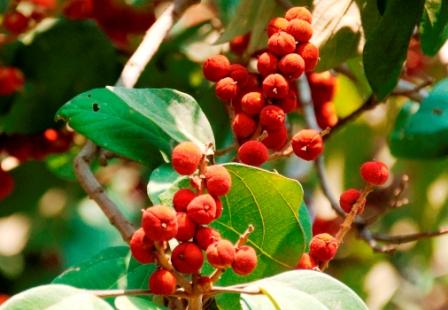
Table of Contents
Vernacular names
Names in different languages:
Hindi name- Kabila
English name- Kamala, Monkey face tree
Arabic name: Kambil
Assamese name: Lokhan
Gujarati name: Kamilo
Kannada name: Kunkundamar, Chandranettu, Kapila
Kashmiri name: Kammelak
Malayalam name: Kurmadakku, Kampippala
Marathi name: Shendari, Kapila
Oriya name: Kapilogendi
Tamil name: Kungumam
Telugu name: Kunkum
Urdu: Kamila
Sanskrit Synonyms
Raktanga, Raktachurnaka, Ranjaka, Lohitanga – The fruit is red in color
Karkash- The fruit is rough outside
Chandra – Cure many diseases
Padodaka – Powder if mixed with water can be used as coloring agent for clothes
Vrana sodhana – Cleanses the wound
Rechi, Rechanaka, Vireki- Cause purgation
Rakta Samana, Varnashodhana,
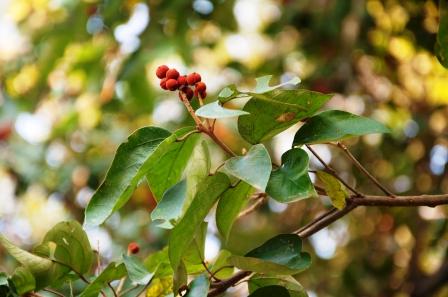
Morphology
Morphology of Mallotus philippensis:
Kampillaka is a medium size tree growing to a height of 20-25 meter and found all over India up to an altitude of 5000 feet. The bark of the tree is brown outside and reddish inside. The leaves are 3-5 inch long, little round to long in shape with hair like structures on the lower surface, whereas the upper surface is smooth. The flowers are unisexual, pale yellow and are found in the month of August- September. The fruits are round, 0.5 inch in diameter and covered with red hair like structures. These hair like structures are collected and used as medicine. Fruits are seen in the month of March- May. The seeds are round, black and slimy in nature.
Test for purity
Test for purity of Kampillaka:
Brick powder is used as an adulterant for Kampillaka. Hence to check the quality, the following test can be done-
- The hair of the fruit is put in a bowl of water. The hairs float in water whereas the brick powder sink in the water.
- If the hair of the fruit is rubbed over a white paper, it gives a yellow line.
- If the hair of the fruit is sprinkled over fire, it gives a crackling appearance.
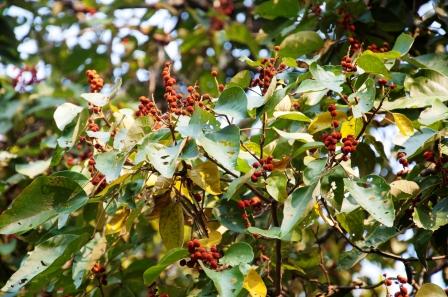
Properties, part used, dosage
Medicinal properties of kampillak:
Rasa (Taste) – Katu (Pungent)
Guna (Qualities) – Laghu (Light for digestion), Ruksha (Dry in nature), Teekshna (Strong)
Vipaka – Katu (Undergoes Pungent taste after digestion)
Veerya (Potency) – Ushna (Hot)
Karma (Actions) – Kaphavata shamaka (reduces vitiated kapha and vata dosha)
Part used- Glands and hair of fruit
Dosage-
Hair of fruit- 1-2 g
Purification method
Kampillaka Shodhana (purification):
Kampillak, being the fruit skin powder, is very light in nature. It is put into water. All the impurities will settle down while the Kampillaka floats. The floating particles are collected, dried and preserved.
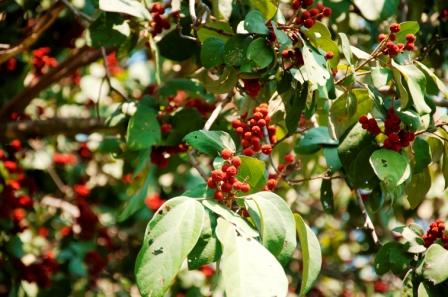
Chemical composition
The most important active constituent is a brownish red or reddish yellow color called Rottlerin. Capsule hair and glands gave phloroglucinol derivatives; rottlerin, isorottlerin, isoallorottlerin (the “red compound”) and methylene-bis-methyl- phloroacetophenone (the“yellow compound”). Two more compounds designated as kamalins 1 and 2 have been isolated. The stem bark contains kamaladiol- 3-acetate and friedelin.
Uses
- The hair of the fruit of Kampillaka is mixed with sesame oil and applied over the skin affected with eczema and wound as part of treatment.
- Mallotus philippinensis fruit gland is used for the treatment of intestinal worms by mixing it with hot water and consuming.
- Decoction of the fruit hair is given in a dose of 30-40 ml to retain the fetus in pregnancy condition.
- Cold infusion of the bark is given in a dose of 40- 50 ml to treat renal calculi and in retention of urine.
- Decoction of the bark of Mallotus philippinensis is given in a dose of 30 ml to treat skin diseases like eczema and acts like a blood purifier.
Sanskrit verse
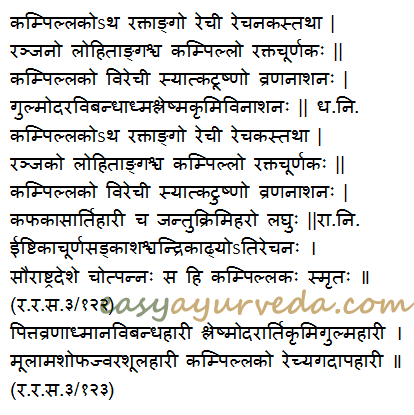
Indications
Traditional indications of Kampillaka:
Vrana – Ulcers, wounds
Gulma – Tumors of the abdomen
Udara – ascites, enlargement of the abdomen
Vibandha – constipation
Adhmana – bloating, gaseous distension of abdomen
Shleshma krumi – parasites of Kapha origin
Kaphajakasa – cough of Kapha origin
Pitta Vrana – Ulcers, wounds
Ama – A product of indigestion and altered metabolism
Shopha – inflammation
Jwara – fever
Shoola – abdominal colic pain
Adverse effects
Increased dose of Kampillaka can cause purgation and excessive salivation. Hence the herb should be used with caution.
Interaction with medicines, supplements
Can this be used while taking Homeopathic medicine?
Yes. This product does not react with homeopathic medicine.
Can this medicine be continued while taking supplements like multivitamin tablets, Omega 3 fatty acids etc?
Yes. Generally, this product goes well with most dietary supplements. However, if you are taking more than one product per day, please consult your doctor for an opinion.
With western
medicines
Seek your
doctor’s advice if you are taking this product along with other western
(allopathic / modern) medicines. Some Ayurvedic herbs can interact with modern
medicine.
If both Ayurvedic and allopathic medicines are advised together, then it is
best to take Allopathic medicine first, wait for 30 minutes and then take the
Ayurvedic medicine.
Ayurvedic medicines
Ayurvedic medicines containing Kampillaka:
Mishraka sneha: It is an Ayurvedic medicine, in herbal ghee form. This medicine has ghee as it is base. It is used for preparatory procedure for Panchakarma and also as medicine, used in the treatment of abscess, Vata diseases etc.
Krimighatini vati: It is an Ayurvedic medicine used in the treatment of intestinal worm infestation, vomiting sensation, inflammatory conditions etc.
Dhanvantara ghrita: It is an Ayurvedic medicine, in herbal ghee form. It is used for the treatment of edema, abscess, hemorrhoids, anemia, toxic conditions, diabetes, diabetic carbuncle, Gout, spleen related diseases, skin and psychotic diseases.
Jivantyadi yamaka: It is an Ayurvedic medicine used for the treatment of various skin ailments – eczema, psoriasis, contact dermatitis, hives and allergic rashes etc.
Vidangadi churna: It is a powder used in treatment of intestinal worms (helminthiasis), anorexia and abdominal pain.
Bala kalpam syrup: It is a proprietary Ayurvedic medicine used for improving liver function and digestive power in children. It is also used to treat colds, bronchitis, nausea, vomiting and infantile regurgitation.
Research
Research articles related to Mallotus philippensis:
Anti- oxidant activity: Phenolic compounds were extracted from Mallotus philippinensis bark using methanol. The content of total phenolics in the fractions ranged from 54 mg/g (fraction I) to 927 mg/g (fraction VI). Condensed tannins were detected in fractions II–VI. Total antioxidant activity (TAA) of phenolic fractions of Mallotus philipinensis bark extract ranged from 0.58 mmol Trolox/g (fraction I) to 6.82 mmol Trolox/g (fraction IV). Fraction IV also showed the strongest antiradical activity against DPPH and reducing power.
Anti- fungal action: From the red coloured extract (Kamala) prepared through acetone extraction of the fresh whole uncrushed fruits of Mallotus philippinensis, one new dimeric chalcone (1) along with three known compounds 1-(5,7-dihydroxy-2,2,6-trimethyl-2H-1-benzopyran-8-yl)-3-phenyl-2-propen-1-one (2), rottlerin (3) and 4′-hydroxy rottlerin (4) were isolated. Compounds 1–4 were evaluated for antifungal activity against different human pathogenic yeasts and filamentous fungi. The antiproliferative activity of the compounds was evaluated against Thp-1 cell lines. Compounds 1 and 2 both exhibited IC50 of 8, 4 and 16 μg/mL against Cryptococcus neoformans PRL518, C. neoformans ATCC32045 and Aspergillus fumigatus, respectively.
Anti- diabetic action: In the present work the antidiabetic activity of the Mallotus philippinensis was evaluated. The hydro ethanolic bark extract showed significant increase in the levels of body weight, insulin and significant decrease in blood glucose, and glycosylated hemoglobin when administered orally for 30 days to STZ induced diabetic rats at a dose of 200 and 400 mg/kg body weight.
Classical categorization
Dhanvantari Nighantu- Chandanadi varga
Raja Nighantu- Suvarnadi varga
Rasa Ratna Samuccaya – Sadharana Rasa
Author: Dr.B.K.Prashanth M.D (Ayu), Ph.D
E mail: drprashanthbk@gmail.com
Click to consult Dr Prashanth BK
Sthanika Karma (Systemic Action)
External – Anti microbial, Cleanses the wounds and promotes healing. Oil is indicated in various types of skin disorders.
Digestive System – It has purgative and Ant helminthic action. Effective in Helminthiasis, Ascites, Phantom tumor etc.
Circulatory System – Acts as a blood purifier.
Excretory system – Ashmarubhedana (Helps to breakdown and expels renal calculi)
Reproductive System – It has contraceptive action.
Skin – Indicated in various skin disorders











2 comments on “Kampillaka: Mallotus philippensis Uses, Research, Remedies”
Megha
Sir, can Kampilaka seeds powder be used used if Kampilaka fruits powder is not available? Mainly for intestinal worms.
Dr J V Hebbar MD(Ayu)
No.